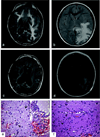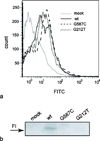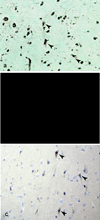Mutations of complement factor I and potential mechanisms of neuroinflammation in acute hemorrhagic leukoencephalitis
- PMID: 22926405
- PMCID: PMC3540165
- DOI: 10.1007/s10875-012-9767-z
Mutations of complement factor I and potential mechanisms of neuroinflammation in acute hemorrhagic leukoencephalitis
Abstract
Purpose: Acute Hemorrhagic Leukoencephalitis (AHLE) is a rare demyelinating disorder of acute onset, rapid deterioration and significant morbidity and mortality. Most often described as a post-infectious complication of an upper respiratory illness, its precise pathophysiology remains unclear. We describe two pediatric patients with AHLE with partial complement factor I (FI) deficiency whose successful treatment included the interleukin-1 (IL-1) receptor antagonist, anakinra, implicating a role for FI and IL-1 in this disorder.
Methods: Extensive clinical workup of two patients presenting with AHLE revealed complement abnormalities, specifically related to the alternative pathway and its regulator, FI. Aggressive management with steroids, immunoglobulin, and anakinra ultimately led to improvement of clinical status and near return to neurologic baseline in both patients. Genetic sequencing of the FI coding regions of the patients and their families was performed. In vitro protein expression studies and immunohistochemistry of fixed brain tissue was used to investigate pathogenic mechanisms.
Results: Two novel mutations in FI were identified in our patients, which result in failure to secrete FI. Immunohistochemical evaluation of brain tissue demonstrated positive staining for C3, membrane attack complex (MAC) and IL-1.
Conclusions: We propose AHLE is an unreported, rare phenotype for partial FI deficiency. The upregulation of C3, MAC and IL-1 with subsequent demyelination support a pathologic role for complement activation in AHLE, and suggest anakinra as an important adjunctive therapy in this disease.
Conflict of interest statement
Figures





References
-
- Payne ET, Rutka JT, Ho TK, Halliday WC, Banwell BL. Treatment leading to dramatic recovery in acute hemorrhagic leukoencephalitis. J Child Neurol. 2007;22:109–113. - PubMed
-
- Leake JA, Billman GF, Nespeca MP, Duthie SE, Dory CE, Meltzer HS, et al. Pediatric acute hemorrhagic leukoencephalitis: report of a surviving patient and review. Clin Infect Dis. 2002;34:699–703. - PubMed
-
- Peterson B, Khanna S, Fisher B, Marshall L. Prolonged hypernatremia controls elevated intracranial pressure in head-injured pediatric patients. Crit Care Med. 2000;28:1136–1143. - PubMed
-
- Ponce-Castro IM, Gonzalez-Rubio C, Delgado-Cervino EM, Abarrategui-Garrido C, Fontan G, Sanchez-Corral P, et al. Molecular characterization of Complement Factor I deficiency in two Spanish families. Mol Immunol. 2008;45:2764–2771. - PubMed
-
- Nilsson SC, Karpman D, Vaziri-Sani F, Kristoffersson AC, Salomon R, Provot F, et al. A mutation in factor I that is associated with atypical hemolytic uremic syndrome does not affect the function of factor I in complement regulation. Mol Immunol. 2007;44:1835–1844. - PubMed
Publication types
MeSH terms
Substances
Grants and funding
LinkOut - more resources
Full Text Sources
Miscellaneous

